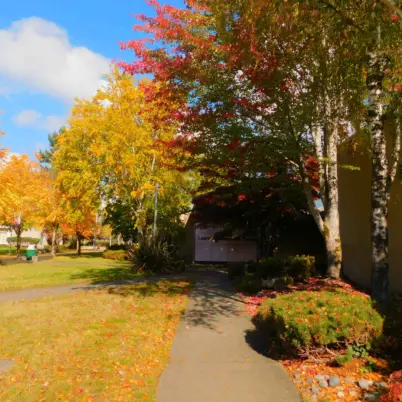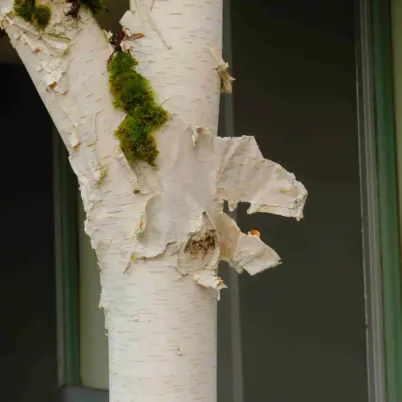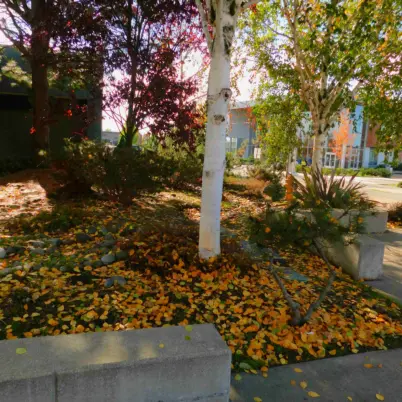Birch: A Campus Beauty with a Long History

Marcia Wilson
On campus glows papery yellow leaves over snow-white trunks. Fall is the season of a tree whose European name means “to shine”. The planting followed thousands of years of tradition between the birch trees and the humans. Birch are truly great beauties with a lot of market value in streambank stabilization and timbering, but also for their aesthetic value. Few trees are as pretty as a birch throughout the seasons. The following is a short list of some of its uses, some of which are as valuable and culturally important as ever.
For the Anishinaabe, also known as the Ojibwe, the birch tree is the Tree of Life, vital to their survival and their culture. Even the name Ojibwe is thought to come from the word “ozhibii’ige,” meaning “to write,” referring to inscriptions on birch scrolls and books. Used for baskets, homes, transportation, food, and medicine, birch has been deeply rooted in Ojibwe life since time immemorial.– WIIGWAAZII:
THE EVOLVING TRADITIONS OF BIRCH EXHIBIT

Birch is Bright: Birch trees are usually very pale to white as snow. Birch comes from the Proto-Indian-European word “to shine; bright”. It hints to its ancient role in recorded history; the peoples of the northern climates used it to make written records, designs, and toys.
I Verbed Your Noun
One of “those things” about the English language is flexibility. Birch was flexible too, and used to make whips. Harsh schoolmasters for centuries have “birched” (whipped with a birch wand) naughty students.
Birch for Dinner
Birch flour bread was made from the soft inner bark of mature trees throughout the world but the outer bark layers and split wood made baskets, plates, tableware, and the table too! In parts of the world where woodstoves still cook the majority of food, seasoned birch is known for producing a very short, hot fuel. “Birch is for biscuits,” exclaimed a boy who lived off-grid.
Honeybees and birch trees. Property owners often groan at how spring means everything is covered in a fine greenish-golden waterfall of dust. Bees, however, rely on it for survival and bee-keepers value it among the top of their crop trees. Birch flowers earlier than most trees and much of this pollen is taken to the hives to make bee bread: a food for the emerging larvae about to become hard-working adults. Bees also harvest propolis: lumps of resin for ‘roofing and shingling’ their homes from the wet weather.
“River birch tree sap is known to cause babies to be born naked and to make your hair turn gray when you’re old. Other than that, the sap that is dripping from the cut branches is harmless.”—Walter Reeves
Drink, Ye Scurvy Dogs!
- Birch tea makes a light, wintergreen flavored drink that kept away scurvy (a fatal deficiency of Vitamin C).
- Birch beer is root beer based on birch, not sassafras. New Englanders still sell it, using recipes from the 17th century.
- Kombucha Over Here: Students drinking their kombucha on campus may be interested to know where it started. Kombucha is a very old drink that started as a fermented tea of honey and the chaga mushroom growing in birch forests. Some readers may be old enough to remember that the word began entering American newspapers after Chernobyl: The population was drinking copious gallons of the stuff in hopes of counteracting the negative effects of radiation. Today it is a multi-million dollar drink industry.
You’re No Sap
Calling someone “a sap” isn’t nice. It was originally an insult between rival trades! Trees were an indispensable source of materials around which humans depended for survival, and woodworkers used hard, seasoned wood for producing lumber, shake, furniture, charcoal and firewood. We use birch for musical instruments, skateboards, and many toothpicks. Green-wood is full of sap, weak, and not useful to these craftsmen. The British insult “to make a bodge of it” is a direct attack against the Bodgers, a group of specialised craftsmen that manufactured items out of the greenwood.
That’ll Shoe You: Birch was arguably used to make everything. This only makes sense: it is one of the few cold-hardy hardwoods that can quickly repopulate a land. Humans learned to make do or do without. Birch made walls, roofs, tools, musical instruments, timber, planking, baskets, and even plaited into shoes.
Birch Tar: Birch belongs to the Betula genus. Betula is a Latin form of the Gaulish word for bitumen, birch tar. It is a natural crazy glue used to fletch arrows and waterproof leather since Neolithic days. Nowadays, pitch means asphalt, but the birch pitch came first.
Birch Saves Forests.

Birch trees are resilient to cold and will produce more branches on the sun-bearing sides of the tree. In old forests the trees turn top-heavy as they seek the sun. Naturally, this causes many a mature tree to fall down under the weight of a heavy snow. Birch wood decays quickly in the forest and creates dense miniature ecosystems of fungi, insect, mammal, and bird species. The heavy drifts of birch pollen, blossoms, and seeds collect swiftly in small nooks and crannies and break down over the winter. A superfast soil generator, this soft, wet soil adds to the health of the forest and also lowers the impact of wildfires.
An Odd Problem
In the wild a paper birch like the ones shown here can easily live over 120 years. Cultivated species rarely live longer than 40. Horticulturists believe insufficient irrigation and sunlight are the causes. For now, the CPTC birch are showing good health and are expected to delight the Lakewood Campus for many more years.